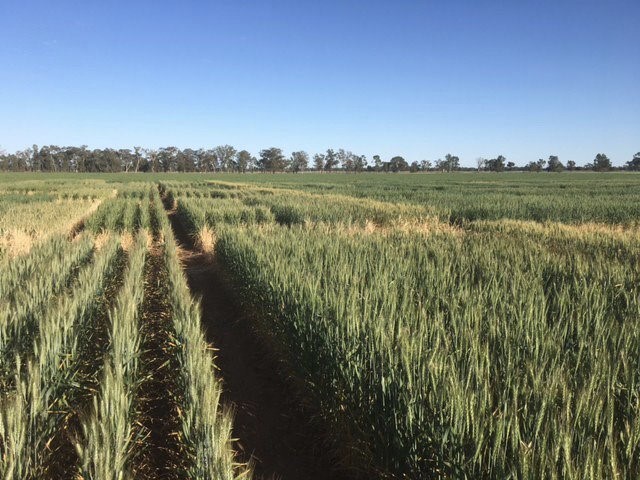How to choose a new wheat variety
10 May 2022
Each season National Variety Trials (NVT) are conducted across the country to provide producers with information about the potential suitability of new crop varieties. With many new varieties entering these trials each year, it can be a little difficult to determine which variety may be a suitable investment. Either, to include as part of your existing suite of grains or to replace an older variety. In this article I will provide five characteristics which can be used as steps to evaluate how well a new variety will fit into your cropping program (Figure 2).

Figure 2. Example of new varieties in a National Variety Trial.
- Yield
As they say, yield is king when it comes to growing crops. It has the largest impact on the bottom line and is highly influential on the selection of a new variety. I would recommend producers look at the NVT website and make a side-by-side yield comparison from your local trial site. This will help identify the highest yielding varieties that may suit your farming system. I also like seeing how a variety has fared in previous seasons, not just last year. This is to identify the influence of a growing season on yield. For example, a variety which finishes quickly will suit an environment where typical temperatures are quite hot come September and October. However, if recent trial data was from a year with an unusual soft finish, then other varieties may look more impressive. Looking at results from nearby locations, which may be a little further west or east, can also be helpful, demonstrating how a variety may handle a slightly different climate. This can give some indication of how it may perform locally in an abnormal season.
- Grain Quality
Understanding a variety’s ability to accumulate protein is important to consider, particularly in grain-only situations, as it can have a significant impact on the bottom line. However, it is also worth considering the likelihood of screenings and other grain quality issues before purchasing a new variety. Some breeding lines do tend to have a higher tendency towards small grain sizes when finishes are tougher than average. This reduces the flexibility of a variety and minimises its use for later sowing opportunities.
- Sowing Window & Growth Habit
Having multiple varieties, with different sowing windows, can help mitigate risk as well as stagger the workload during autumn. If replacing a variety, it would be beneficial to find another that fits within the same window for this reason. It could also be an opportunity to expand your sowing window and incorporate something new, to capitalise on different seasons. It can then be beneficial to know if a wheat is an early, main season or late variety. The same goes for its growth habit. Is it a winter or spring type? Is it heavily influenced by the length of the day? Will it finish quickly once it goes reproductive? These are all good questions to ask when assessing various wheat varieties and can be answered by getting in contact with your local reseller, LLS ag advisor or the relevant seed company.
- Plant Height
Over the last two seasons I have had several conversations with various producers around lodging. Tall varieties with big heads mixed with heavy winds have made some producers reconsider what they will plant in 2022. Typically, this has been a common issue in barley, and as a result semi-dwarf varieties have had great success. While lodging can still be common in wheat, like barley, there are varieties which produce shorter plants, where lodging is less likely to occur.
The other consideration about growing big plants is the amount of residue remaining after harvest. While maintaining stubble cover is essential for increasing water infiltration over summer, some varieties produce such thick stubble that it impedes sowing the following season. Some early sown grain-only varieties (sown before May) are common culprits of this, producing large bulky plants.
- Disease Tolerance While low tolerance to a disease is not ideal, it doesn’t always mean that that variety is a complete write off. It just means it needs to be managed accordingly. One to two fungicide applications may be required throughout the growing season if an infection is found and seen to be spreading in-crop. However, if there is a new variety with a similar, if not better, yield potential, occupies the same sowing window and has better tolerance against disease, then it would be worth considering a transition.
It is important to understand that varieties will typically receive two fungicide applications in the NVTs, so that disease doesn’t limit yield. Hence, a variety may look great in a trial but if a producer doesn’t also manage a variety, with low disease tolerance, in the same way, then results could be quite different. It can pay to read NVT protocols and understand the steps taken to grow the variety you are considering.
Conclusion
Considering a variety by evaluating it on a range of characteristics, on top of yield potential, can quickly inform a producer whether it will be a good fit for their cropping program. For more information on wheat varieties contact your local LLS ag advisor.